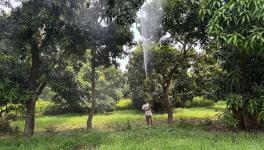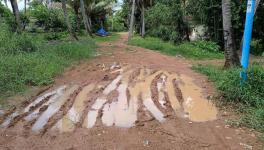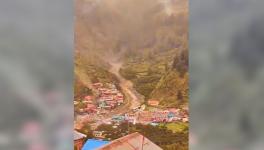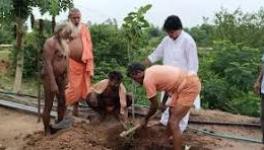Death & Displacement: Bengal’s Climate Wake-Up Call
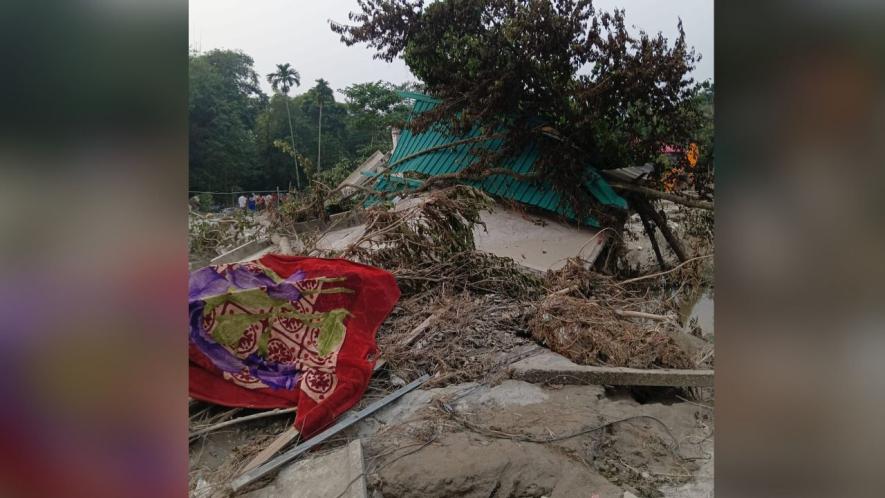
Kolkata: The rain didn’t knock. It broke in.
In the early hours of October 3, the hill town of Mirik, perched among the misty folds of North Bengal, was shaken awake by a sound locals now describe as “the mountain crying.” Landslides ripped through slopes and tea gardens, swallowing homes, roads, and the iron bridge at Dudhia — a crucial lifeline linking Siliguri with Sikkim. By dawn, the region had changed shape. At least 28 people were dead across Darjeeling, Kalimpong, Jalpaiguri, and Alipurduar. Over a hundred landslides were recorded in just two days, cutting off remote villages and leaving thousands stranded.
Six hundred kilometres to the south, Kolkata was drowning. On September 23, the city received 250 millimetres of rainfall in a single day — nearly 12% of its annual average. Streets became rivers. Buses floated half-submerged. Manholes exploded under pressure. In Topsia, Tiljala, and Garden Reach, residents waded through waist-deep floodwater, clutching their children and belongings. Power lines snapped. Sewage mixed with stormwater. The city’s century-old drainage system — some of it built under the British — buckled under the deluge.
What unfolded was not an isolated freak event. It was a climate flashpoint — a collision of natural vulnerability and political neglect. It exposed the fault lines, both geological and bureaucratic, that run through West Bengal’s disaster response.
The Science Is Clear. The State’s Response Isn’t.
Meteorologists have long warned of a changing monsoon pattern. The Bay of Bengal, one of the world’s warmest seas, is heating faster than the global average. “Short, violent bursts of rain are replacing steady monsoon spells,” explained Habibur Rahaman Biswas, a climate scientist at the India Meteorological Department (IMD). “That means more flash floods, more landslides, more chaos,” he added.
The IMD confirms this shift. North Bengal recorded 42% more rainfall than the seasonal average, while Kolkata’s September rainfall was the highest in over a decade. Across Eastern India, the number of “very heavy rainfall” days — over 200 mm in 24 hours — has more than doubled since 2000.
Yet, despite the clarity of the data, the state’s preparedness remains muddled. In the hills, early warning systems failed. Sirens didn’t sound in several villages until after the slides had begun. Evacuation protocols were unclear, and relief teams struggled to reach cut-off areas because roads and bridges had vanished overnight.
In Kolkata, the story was equally grim. The city’s flood-risk maps haven’t been updated since 2015. The pumps that keep central Kolkata dry during monsoons malfunctioned, while storm drains clogged with plastic waste, and silt turned neighbourhoods into stagnant ponds. The Kolkata Municipal Corporation blamed “unprecedented rainfall,” but residents know the pattern too well: each year brings bigger floods and smaller excuses.
Infrastructure Crumbling Under Climate Pressure
The economic cost of the twin disasters is still being counted. In Salt Lake, IT offices and call centres were inundated, their servers short-circuited. In Behala and Tollygunge, ambulances couldn’t reach patients. Schools closed for days. Early estimates peg the losses at several hundred crores.
A senior municipal engineer, requesting anonymity, offered a blunt assessment: “We’ve been warning about this for years. The drainage lines are decades old. Encroachments on canals, poor desilting, and construction on floodplains have made the city a flood trap.”
Indeed, much of Kolkata sits barely above sea level, its natural wetlands long devoured by unplanned expansion. The East Kolkata Wetlands, once a natural sponge absorbing excess rain, have been steadily shrinking under real estate pressure. What remains of them is choked by illegal dumping and neglect.
The state’s flagship climate document — the State Action Plan on Climate Change (SAPCC) — exists mostly on paper. Experts say it is underfunded, outdated, and fragmented across departments that rarely coordinate.
“Disaster management here is reactive, not proactive,” said environmental lawyer D. Banerjee, adding “We wait for tragedy, then announce compensation. There’s no systemic planning, no accountability.”
Ecological Damage: A Silent Casualty
Beyond the visible destruction, the ecological toll is mounting. In the Dooars, landslides ripped through forest corridors vital for elephants and leopards. “We lost two elephant calves in the rain,” said a forest guard near Buxa Tiger Reserve, adding “Soil erosion is severe. Even hornbill nesting trees have collapsed.”
The fragile Himalayan foothills, already destabilised by reckless construction and quarrying, are now at breaking point. Roads carved into steep slopes without proper drainage, act like channels for disaster, directing water and debris downhill. Environmentalists have long opposed the unchecked proliferation of hydropower projects and highways in the region, but their warnings rarely make it past bureaucratic files.
Further south, the Sundarbans — the world’s largest mangrove delta — faced a different but equally cruel blow. Heavy rains and swollen rivers pushed saline water deep into freshwater ponds, ruining fish farms and contaminating drinking sources. Mangrove regeneration projects were washed away. “We had just planted 40,000 saplings after Cyclone Remal,” said a conservation worker from Gosaba, adding “Half of them are gone. The soil is too salty again.”
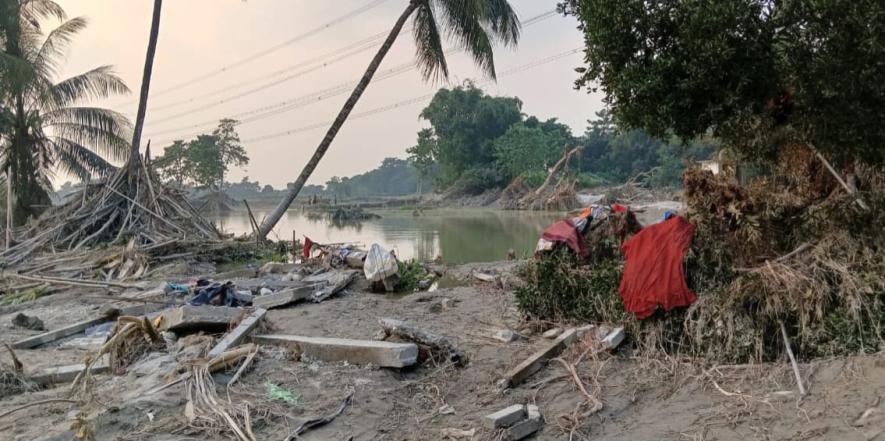
Each ecological loss ripples outward — from wildlife to livelihoods, from biodiversity to food security. Yet these are the damages least visible in government press releases.
The Human Cost: Invisible Until Election Time
Disasters reveal not only the force of nature but also the fault lines of inequality.
In Kalimpong, 17-year-old Pema Tamang now lives in a relief camp. She lost her grandmother and her home when the hillside gave way. “We heard a rumble and ran,” she recalled, staring at the mountains that still seem to give her nightmares. Her school remains closed indefinitely.
In Kolkata’s Tiljala, Nasreen Bibi, 42, sits beside her ruined sewing machines. “They say the city will be ‘smart’. But for us, it’s drowning,” she said bitterly, adding “We are invisible until election time.”
Women and children bear the brunt of such crises — from displacement to disease and trauma. Relief distribution was uneven and slow. Official camps often ran out of food. Many families depended on community kitchens set up by local NGOs and youth volunteers who used their own savings to distribute dry rations and medicines.
“The government came after the media cameras arrived,” said social worker Arpita Ghosh, who coordinated relief in Topsia, adding “Till then, it was ordinary people helping each other.”
A Fork in the Road
West Bengal now stands at the crossroads. Floods and landslides are not acts of fate; these are symptoms of a deeper crisis. A warming climate, eroding hills, vanishing wetlands — all aggravated by unplanned development and institutional apathy.
Experts warn that unless the state invests in resilient infrastructure, early-warning systems, and community-based adaptation, such disasters will only multiply. Kolkata’s drainage system needs a complete overhaul. The hills need regulated construction and slope stabilisation. The Sundarbans need sustained protection, not token replanting drives.
Climate change is no longer a distant spectre. It is here — reshaping lives, landscapes, and futures. The question for West Bengal, and for India at large, is no longer whether we can afford to act.
It is whether we can afford not to.
Get the latest reports & analysis with people's perspective on Protests, movements & deep analytical videos, discussions of the current affairs in your Telegram app. Subscribe to NewsClick's Telegram channel & get Real-Time updates on stories, as they get published on our website.












